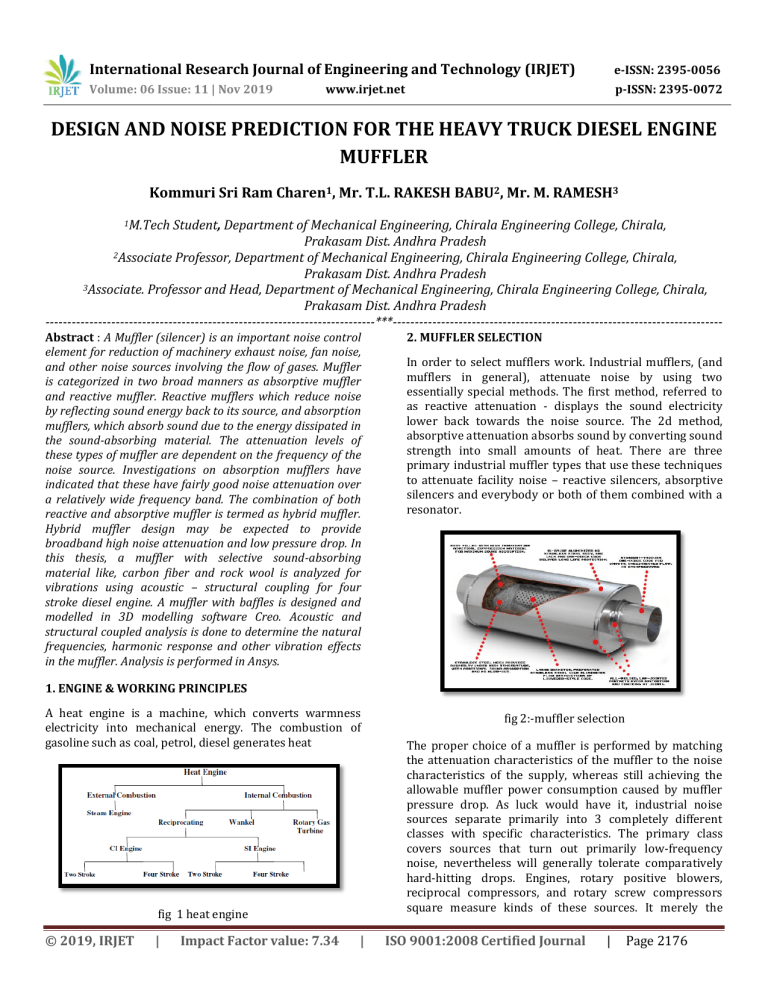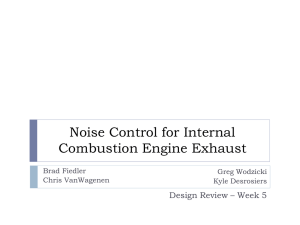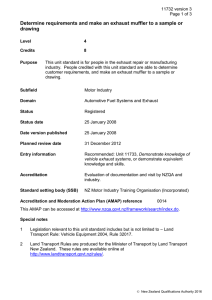IRJET-Design and Noise Prediction for the Heavy Truck Diesel Engine Muffler
advertisement

International Research Journal of Engineering and Technology (IRJET) e-ISSN: 2395-0056 Volume: 06 Issue: 11 | Nov 2019 p-ISSN: 2395-0072 www.irjet.net DESIGN AND NOISE PREDICTION FOR THE HEAVY TRUCK DIESEL ENGINE MUFFLER Kommuri Sri Ram Charen1, Mr. T.L. RAKESH BABU2, Mr. M. RAMESH3 1M.Tech Student, Department of Mechanical Engineering, Chirala Engineering College, Chirala, Prakasam Dist. Andhra Pradesh 2Associate Professor, Department of Mechanical Engineering, Chirala Engineering College, Chirala, Prakasam Dist. Andhra Pradesh 3Associate. Professor and Head, Department of Mechanical Engineering, Chirala Engineering College, Chirala, Prakasam Dist. Andhra Pradesh ---------------------------------------------------------------------------***--------------------------------------------------------------------------Abstract : A Muffler (silencer) is an important noise control element for reduction of machinery exhaust noise, fan noise, and other noise sources involving the flow of gases. Muffler is categorized in two broad manners as absorptive muffler and reactive muffler. Reactive mufflers which reduce noise by reflecting sound energy back to its source, and absorption mufflers, which absorb sound due to the energy dissipated in the sound-absorbing material. The attenuation levels of these types of muffler are dependent on the frequency of the noise source. Investigations on absorption mufflers have indicated that these have fairly good noise attenuation over a relatively wide frequency band. The combination of both reactive and absorptive muffler is termed as hybrid muffler. Hybrid muffler design may be expected to provide broadband high noise attenuation and low pressure drop. In this thesis, a muffler with selective sound-absorbing material like, carbon fiber and rock wool is analyzed for vibrations using acoustic – structural coupling for four stroke diesel engine. A muffler with baffles is designed and modelled in 3D modelling software Creo. Acoustic and structural coupled analysis is done to determine the natural frequencies, harmonic response and other vibration effects in the muffler. Analysis is performed in Ansys. 2. MUFFLER SELECTION In order to select mufflers work. Industrial mufflers, (and mufflers in general), attenuate noise by using two essentially special methods. The first method, referred to as reactive attenuation - displays the sound electricity lower back towards the noise source. The 2d method, absorptive attenuation absorbs sound by converting sound strength into small amounts of heat. There are three primary industrial muffler types that use these techniques to attenuate facility noise – reactive silencers, absorptive silencers and everybody or both of them combined with a resonator. 1. ENGINE & WORKING PRINCIPLES A heat engine is a machine, which converts warmness electricity into mechanical energy. The combustion of gasoline such as coal, petrol, diesel generates heat fig 1 heat engine © 2019, IRJET | Impact Factor value: 7.34 | fig 2:-muffler selection The proper choice of a muffler is performed by matching the attenuation characteristics of the muffler to the noise characteristics of the supply, whereas still achieving the allowable muffler power consumption caused by muffler pressure drop. As luck would have it, industrial noise sources separate primarily into 3 completely different classes with specific characteristics. The primary class covers sources that turn out primarily low-frequency noise, nevertheless will generally tolerate comparatively hard-hitting drops. Engines, rotary positive blowers, reciprocal compressors, and rotary screw compressors square measure kinds of these sources. It merely the ISO 9001:2008 Certified Journal | Page 2176 International Research Journal of Engineering and Technology (IRJET) e-ISSN: 2395-0056 Volume: 06 Issue: 11 | Nov 2019 p-ISSN: 2395-0072 www.irjet.net character of those machines to provide low-frequency noise and has pressure-volume relationships that square measure quite tolerant of system pressure drop. These machines square measure utterly suited to reactive (chambered) silencers. The second class of noise sources is people who turn out primarily high-frequency noise and have performance that's terribly sensitive to system pressure losses. 2.1 Design Procedures Structure methods for resonator suppressors are given in Beranek and Bies and Hansen, yet the procedure is intricate. The methodology is to determine the resounding recurrence of the suppressor and the ideal constriction. A depression volume is determined and afterwards, the territory of the openings (or connectors) between the fumes pipe and the cavity must be determined. At last, a wire or material screen to cover the openings must be picked with the right stream protection from giving the right damping (this diminishes the greatest lessening, yet decreases the impact of the pass bands where no addition misfortune is accomplished). Presenting tailpipes can altogether improve the suppressor execution and increasingly nitty gritty thought of acoustic transmission line hypothesis is required to appropriately structure the tailpipe fig 3 :-Sketch of a reactive muffler with two cavities and no flow restriction Fig 4: cross section view of muffler © 2019, IRJET | Impact Factor value: 7.34 | 3. LITERATURE SURVEY In this paper by Zeynep Parlar[1], Acoustic and Flow Field Analysis of a Perforated Muffler Design. New regulations and standards for noise emission increasingly compel the automotive firms to make some improvements about decreasing the engine noise. Nowadays, the perforated reactive mufflers which have an effective damping capability are specifically used for this purpose. New designs should be analyzed with respect to both acoustics and back pressure. In this study, a reactive perforated muffler is investigated numerically and experimentally. For an acoustical analysis, the transmission loss which is independent of sound source of the present cross flow, the perforated muffler was analyzed by COMSOL. To be able to validate the numerical results, transmission loss was measured experimentally. Back pressure was obtained based on the flow field analysis and was also compared with experimental results. Numerical results have an approximate error of 20% compared to experimental results. Iin this work done by [2], design & optimization of exhaust muffler &design validation. For an automotive exhaust system the noise level, transmission loss & back pressure are the most important parameters for the driver & engine performance. In order to improve the design efficiency of muffler, resonating of the exhaust muffler should be avoided by its natural frequency. Mufflers are most important part of the engine system and it is commonly used in the exhaust system to minimize the sound transmission level which is caused by exhaust gases. The design of muffler becomes more and more important for noise reduction. The solid modelling of exhaust muffler is created byCATIA-V5 and modal analysis is carried out by ANSYS to study the vibration and natural frequency of muffler. So as to differentiate between the working frequency from natural frequency and avoid resonating. In this paper by[3], Design and Fabrication of Muffler for Four Stroke Diesel Engine. The main aim of our research is to design a Muffler for four stroke diesel engine. Muffler is a device which is used for reducing the amount of noise emitted by the exhaust of an internal combustion engine. In this research baffle arrangement are used to resist the flow of the exhaust from the engine. An exhaust pipe must be carefully designed to carry toxic and/or noxious gases away from the users of the machine .Indoor generators and furnaces can quickly fill an enclosed space with carbon monoxide or other poisonous exhaust gases if they are not properly vented to the outdoors. Also, the gases from most types of machine are very hot; the pipe must be heat resistant and it must not pass through or near anything that can burnor damaged by the heat. A chimney serves as an exhaust pipe in a stationary structure. For the internal combustion engine it is important to have the exhaust system “tuned” optimal efficiency. In this work done by [4], Engine Exhaust Noise Control. The exhaust system of a ISO 9001:2008 Certified Journal | Page 2177 International Research Journal of Engineering and Technology (IRJET) e-ISSN: 2395-0056 Volume: 06 Issue: 11 | Nov 2019 p-ISSN: 2395-0072 www.irjet.net generator has several inherent design problems that must be considered. These characteristics impose severe limitations on what can be done to silence the engine exhaust noise. 4. INTRODUCTION TO CREO 2.0 Creo, PTC's parametric, integrated 3D CAD/CAM/CAE solution, is used by discrete manufacturers for mechanical engineering, design and manufacturing. Created via Dr. Samuel P. Geisberg in the mid-1980s, Creo was once the industry's first profitable parametric, 3D CAD modeling system. The parametric modeling strategy makes use of parameters, dimensions, features, and relationships to seize supposed product behavior and create a recipe which allows layout automation and the optimization of design and product improvement processes. Fig 6:- Cross section of pipe with baffles and absorbing layer 8. ACOUSTIC SIMULATION 5. INTRODUCTION TO FEA Finite Element Analysis (FEA) used to be first developed in 1943 by R. Courant, who utilized the Ritz technique of numerical evaluation and minimization of variant calculus to achieve approximate options to vibration systems. Shortly thereafter, a paper published in 1956 with the aid of M. J. Turner, R. W. Clough, H. C. Martin, and L. J. Top established a broader definition of numerical analysis. The paper centred on the "stiffness and deflection of complex structures". Fig 7:- imported model from the Creo 2.0 6. INTRODUCTION TO ACOUSTICS Acoustic analysis is available in the ANSYS Multiphysics and ANSYS Mechanical products. This type of analysis simulates the generation and propagation properties of either the coupled acoustic-structural interaction (FSI) or the uncoupled pure acoustic wave in the given environment. Support is available for modal, timeharmonic, and transient acoustic analysis. 7. MODELING OF MUFFLER FOR FOUR STROKE DIESEL ENGINE Fig 5:- Cross section of pipe with absorbing layer © 2019, IRJET | Impact Factor value: 7.34 Fig8:- meshed body Fig9:- acoustics power level(db)- original model (0.1 kg/s) | ISO 9001:2008 Certified Journal | Page 2178 International Research Journal of Engineering and Technology (IRJET) e-ISSN: 2395-0056 Volume: 06 Issue: 11 | Nov 2019 p-ISSN: 2395-0072 www.irjet.net Fig10:- acoustics power level(db)-modified model Fig13: frequency response for velocity of air-modified model Fig11:-Total Deformation – original model Fig14:-Total Deformation-modified model- rockwool 1. RESULTS & DISCUSSIONS Fig12: frequency response for stress – original model Fig15:- comparison of acoustic power level with different mass flow rate at 450k and models © 2019, IRJET | Impact Factor value: 7.34 | ISO 9001:2008 Certified Journal | Page 2179 International Research Journal of Engineering and Technology (IRJET) e-ISSN: 2395-0056 Volume: 06 Issue: 11 | Nov 2019 p-ISSN: 2395-0072 www.irjet.net [4] Shubham Pal , Tejpreet Singh Golan , Vinod Kumar , Virag Jain, Nilesh Ramdas, O. P. Sharma, Design of a Muffler & Effect of Resonator length for 3 Cylinder SI Engine, IOSR Journal of Mechanical and Civil Engineering (IOSR-JMCE), e-ISSN: 2278-1684,p-ISSN: 2320-334X, Volume 11, Issue 3 Ver. VII (May- Jun. 2014), PP 85-91 [5] JINSIANG SHAW, Design and Control of Active Muffler in Engine Exhaust Systems, Research Gate [6] Igolkin A.A., Kruchkov A.N., Shakhmatov, Calculation and Design of Exhaust noise mufflers for Power Engineering Equipment, 8th International Symposium TRANSPORT NOISE AND VIBRATION, 4–6 June 2006 Fig16:- comparison of deformation with different mass flow rate [7] Meda Lakshmikantha & Mathias Keck (2013), Optimization of Exhaust Systems, SAE Paper No. 200201-0059, 2002. 2. CONCLUSIONS In this thesis, a muffler with selective sound-absorbing material like, carbon fiber and rock wool is analyzed for vibrations using acoustic – structural coupling for four stroke diesel engine. A muffler with baffles is designed and modelled in 3D modelling software Creo. The following conclusions can be made from the analyses results: The acoustic power level is decreasing for the modified model than original model. So the sound level from the engine is less when modified model is used. When the material Rockwool is used, the sound level is lesser. REFERENCES [1] S.Balamurugan, N.Jeyaprakash, K.Manikandan, Design and Fabrication of Muffler for Four Stroke Diesel Engine, (ISSN: 2277-1581) Volume No.4 Issue No.3, pp: 136-140 01 March. 2015 [8] Atul A. Patil, Dr. L. G. Navale, Dr. V. S. Patil, Simulative Analysis of Single Cylinder Four Stroke C.I. Engine Exhaust System, Pratibha International Journal of science, Spirituality, Business and Technology (IJSSBT), Vol. 3, ISSN (print) 2277-7261, 79-84. [9] D.S. Deshmukh, J.P. Modak and K.M. Nayak (2010) Experimental Analysis of Backpressure Phenomenon Consideration for C.I. Engine Performance Improvement, SAE Paper No. 2010-01-1575, International Power trains, Fuels & Lubricants Meeting, Rio De Janeiro, Brazil, on dated- 5. [10] A.A. Patil, D.S. Deshmukh, L.G. Navale and V.S. Patil (2011), Experimental Investigation of a C.I. Engine Operating Parameters For Energy Efficient Exhaust System, Development International Journal of Innovations In Mechanical & Automobile Engineering (IJIMAE), ISSN 2249-2968 (Print), Issue – I, Vol. -II, 6064 [2] Shital Shah, Kalyankumar S Hatti, Dhananjay Thombare, A Practical Approach towards Muffler Design,Development and Prototype Validation, Article in SAE International Journal of Engines, September 2010, DOI: 10.4271/2010-32-0021 [3] Rahman, T. Sharmin, A F M E. Hassan, and M. Al Nur, Design and construction of a muffler for engine exhaust noise reduction, Proceedings of the International Conference on Mechanical Engineering 2005 (ICME2005) 28- 30 December 2005 © 2019, IRJET | Impact Factor value: 7.34 | ISO 9001:2008 Certified Journal | Page 2180



